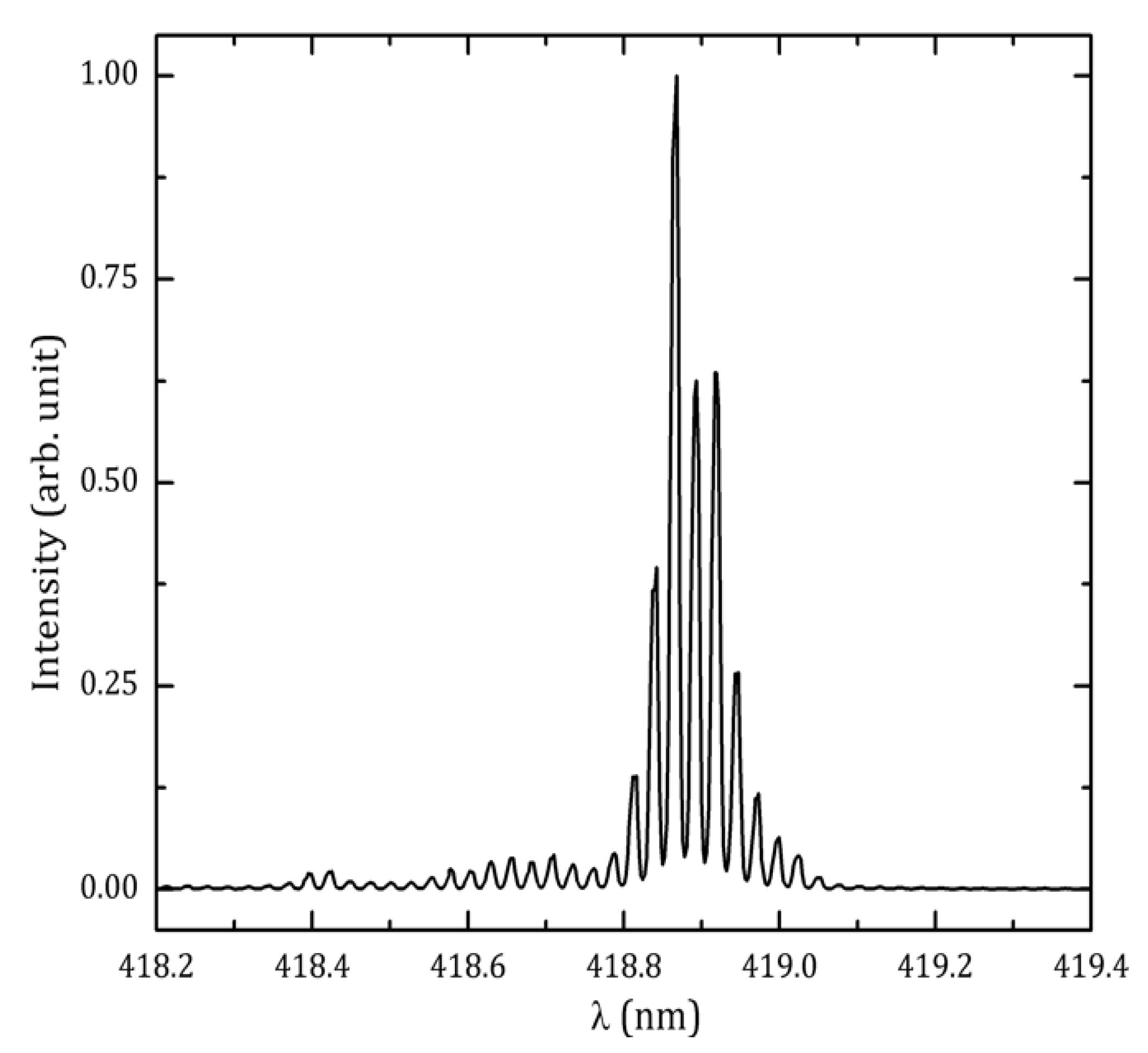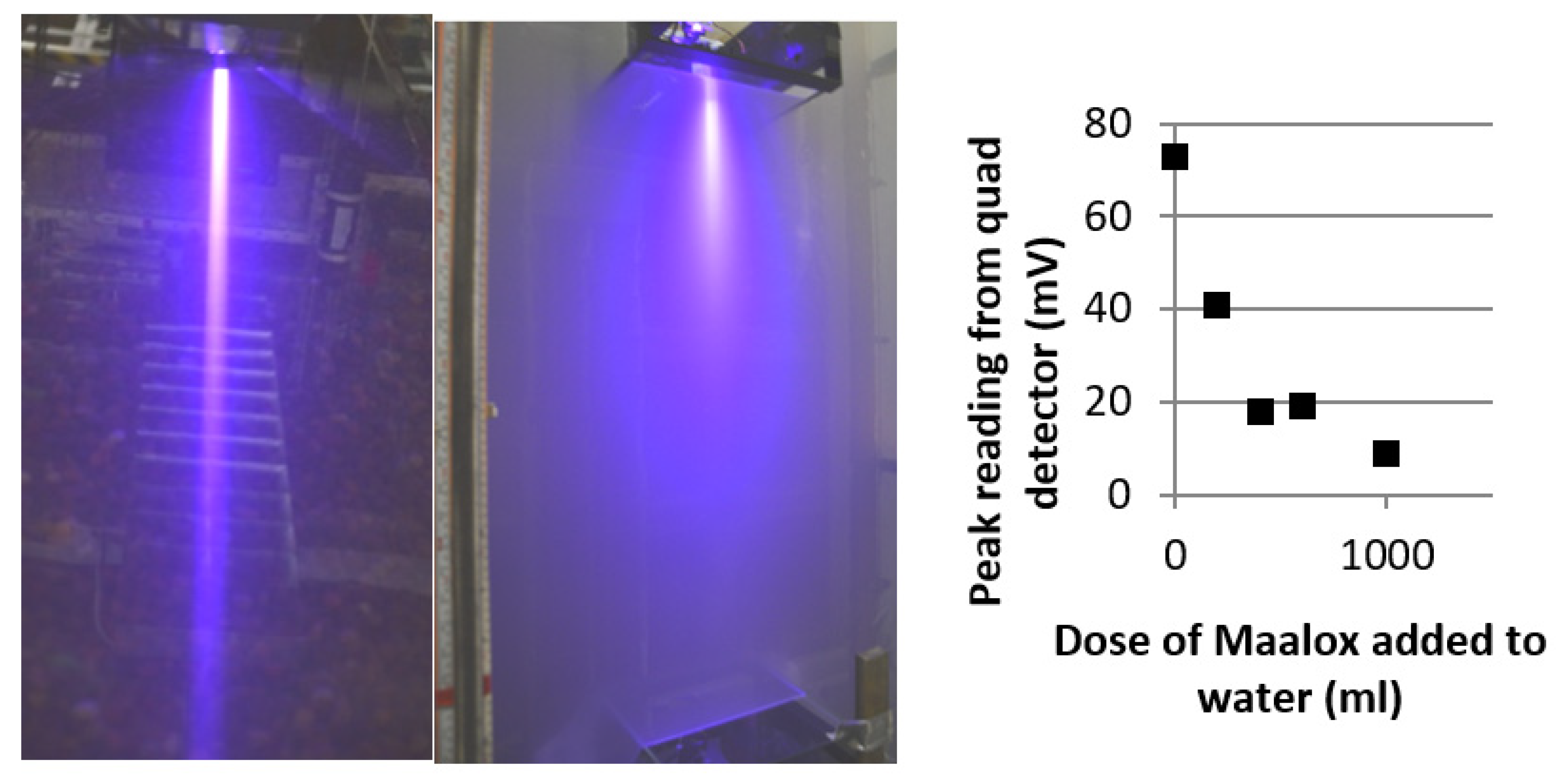GaN Laser Diode Technology for Visible-Light Communications
Abstract
:1. Introduction
2. Materials
3. Results
3.1. GaN Laser Diode Free-Space Data Transmission
3.2. GaN Laser Diode Underwater Data Transmission
3.3. GaN Laser Diode Data Transmission in Plastic Optical Fibers (POFs)
3.4. Visible DFB GaN LDs
3.4.1. Design and Fabrication of Visible DFB GaN LDs
3.4.2. 39th-Order DFB GaN LD Characterization
3.4.3. Third-Order DFB GaN Laser Diode Characterization
4. Conclusions
Author Contributions
Funding
Acknowledgments
Conflicts of Interest
References
- O’Brien, D.; Pary, G.; Stavrinov, P. Optical hotspots speed up wireless communication. Nat. Photonics 2007, 1, 245–247. [Google Scholar] [CrossRef]
- McKendry, J.; Green, R.P.; Kelly, A.E.; Gong, Z.; Guilhabert, B.; Massoubre, D.; Gu, E.; Dawson, M.D. High-speed visible light communications using individual pixels in a micro-light emitting diode array. IEEE Photonics Technol. Lett. 2010, 22, 1346–1348. [Google Scholar] [CrossRef]
- Ferreira, R.X.R.; Xie, E.; McKendry, J.J.D.; Rajbhandari, S.; Chun, H.; Faulkner, G.; Watson, S.; Kelly, A.E.; Gu, E.; Penty, P.V.; et al. High Bandwidth GaN-Based Micro-LEDs for Multi-Gb/s Visible Light Communications. IEEE Photonics Technol. Lett. 2016, 28, 2023–2026. [Google Scholar] [CrossRef] [Green Version]
- Chun, H.; Rajbhandari, S.; Faulkner, G.; Tsonev, D.; Xie, E.; McKendry, J.J.D.; Gu, E.; Dawson, M.D.; O’Brien, D.C.; Haas, H. LED Based Wavelength Division Multiplexed 10 Gb/s Visible Light Communications. J. Light. Technol. 2016, 34, 3047–3052. [Google Scholar] [CrossRef] [Green Version]
- Liu, X.; Tian, P.; Wei, Z.; Yi, S.; Huang, Y.; Zhou, X.; Qiu, Z.; Hu, L.; Fang, Z.; Cong, C.; et al. Gbps Long-Distance Real-Time Visible Light Communications Using a High-Bandwidth GaN-Based Micro-LED. IEEE Photonics J. 2017, 9, 7204909. [Google Scholar] [CrossRef]
- Watson, S.; Tan, M.; Najda, S.P.; Perlin, P.; Leszczynski, M.; Targowski, G.; Grzanka, S.; Kelly, A.E. Visible light communications using a directly modulated 422 nm GaN laser diode. Opt. Lett. 2013, 38, 3792. [Google Scholar] [CrossRef]
- Najda, S.P.; Perlin, P.; Suski, T.; Marona, L.; Leszczynski, M.; Wisniewski, P.; Czernecki, R.; Kucharski, R.; Targowski, G.; Watson, M.A.; et al. AlGaInN laser diode technology for GHz high-speed visible light communication through plastic optical fiber and water. Opt. Eng. 2016, 55, 026112. [Google Scholar] [CrossRef] [Green Version]
- Wang, W.-C.; Wang, H.-Y.; Lin, G.-R. Ultrahigh-speed violet laser diode based free-space optical communication beyond 25 Gbit/s. Sci. Rep. 2018, 8, 13142. [Google Scholar] [CrossRef]
- Wu, T.-C.; Chi, Y.-C.; Wang, H.-Y.; Tsai, C.-T.; Lin, G.-R. Blue Laser Diode Enables Underwater Communication at 12.4 Gbps. Sci. Rep. 2017, 7, 40480. [Google Scholar] [CrossRef]
- Najda, S.P.; Perlin, P.; Suski, T.; Stanczyk, S.; Leszczynski, M.; Schiavon, D.; Slight, T.; Gwyn, S.; Watson, S.; Kelly, A.; et al. GaN laser diodes for quantum sensing and optical atomic clocks. In Proceedings of the SPIE Future Sensing Technologies 2021, Online, 15–19 November 2021; Volume 11914, pp. 5–13. [Google Scholar] [CrossRef]
- Watson, S.; Viola, S.; Giuliano, G.; Najda, S.P.; Perlin, P.; Suski, T.; Marona, L.; Leszczyński, M.; Wisniewski, P.; Czernecki, R.; et al. High speed visible light communication using blue GaN laser diodes. In Proceedings of the Advanced Free-Space Optical Communication Techniques and Applications II, Edinburgh, UK, 26–29 September 2016; Volume 9991, p. 99910A. [Google Scholar] [CrossRef] [Green Version]
- Kang, J.H.; Wenzel, H.; Freier, E.; Hoffmann, V.; Brox, O.; Fricke, J.; Sulmoni, L.; Matalla, M.; Stölmacker, C.; Kneissl, M.; et al. Continuous-wave operation of DFB laser diodes based on GaN using 10th order laterally coupled surface gratings. Opt. Lett. 2020, 45, 935–938. [Google Scholar] [CrossRef] [PubMed]
- Holguin-Lerma, J.A.; Ng, T.K.; Ooi, B.S. Narrow-line InGaN/GaN green laser diode with high-order distributed feedback surface grating. Appl. Phys. Express 2019, 12, 042007. [Google Scholar] [CrossRef]
- Deng, Z.; Li, J.; Liao, M.; Xie, W.; Luo, S. InGaN/GaN distributed feedback laser diodes with surface gratings and sidewall gratings. Micromachines 2019, 10, 699. [Google Scholar] [CrossRef] [Green Version]
- Watson, M.A.; Blanchard, P.M.; Stace, C.; Bhogul, P.K.; White, H.J.; Kelly, A.E.; Watson, S.; Valyrakis, M.; Najda, S.P.; Marona, L.; et al. Assessment of laser tracking and data transfer for underwater optical communications. In Proceedings of the Unattended Sensors and Sensor Networks X, Amsterdam, The Netherlands, 22–25 September 2014; Volume 9248, p. 92480T. [Google Scholar] [CrossRef]
- Kaushal, H.; Kaddoum, G. Underwater Optical Wireless Communication. IEEE Access 2016, 4, 1518–1547. [Google Scholar] [CrossRef]
- Spagnolo, G.S.; Cozzella, L.; Leccese, F. Underwater Optical Wireless Communications: Overview. Sensors 2020, 20, 2261. [Google Scholar] [CrossRef] [PubMed]
- Jaffe, J.S. Underwater Optical Imaging: The Past, the Present, and the Prospects. IEEE J. Ocean. Eng. 2015, 40, 683–700. [Google Scholar] [CrossRef]
- Kagami, M. Visible Optical Fiber Communication. RD Rev. Toyota CRDL 2005, 40, 1–6. [Google Scholar]
- Vinogradov, J.; Kruglov, R.; Engelbrecht, R.; Ziemann, O.; Sheu, J.-K.; Chi, K.-L.; Wun, J.-M.; Shi, J.-W. GaN-Based Cyan Light-Emitting Diode with up to 1-GHz Bandwidth for High-Speed Transmission Over SI-POF. IEEE Photonics J. 2017, 9, 1–7. [Google Scholar] [CrossRef]
- Slight, T.J.; Odedina, O.; Meredith, W.; Docherty, K.E.; Kelly, A.E. InGaN/GaN DFB laser diodes at 434 nm with deeply etched sidewall gratings. In Proceedings of the Gallium Nitride Materials and Devices XI, San Francisco, CA, USA, 13–18 February 2016; Volume 9748, pp. 119–124. [Google Scholar] [CrossRef]
- Najda, S.P.; Perlin, P.; Suski, T.; Stanczyk, S.; Leszczynski, M.; Schiavon, D.; Slight, T.; Gwyn, S.; Watson, S.; Kelly, A.; et al. GaN laser diodes for cold-atom quantum sensors and optical atomic clocks. In Proceedings of the Emerging Imaging and Sensing Technologies for Security and Defence VI, Online, 13–18 September 2021; Volume 11868, p. 118680G. [Google Scholar] [CrossRef]















Publisher’s Note: MDPI stays neutral with regard to jurisdictional claims in published maps and institutional affiliations. |
© 2022 by the authors. Licensee MDPI, Basel, Switzerland. This article is an open access article distributed under the terms and conditions of the Creative Commons Attribution (CC BY) license (https://creativecommons.org/licenses/by/4.0/).
Share and Cite
Najda, S.P.; Perlin, P.; Suski, T.; Marona, L.; Leszczyński, M.; Wisniewski, P.; Stanczyk, S.; Schiavon, D.; Slight, T.; Watson, M.A.; et al. GaN Laser Diode Technology for Visible-Light Communications. Electronics 2022, 11, 1430. https://doi.org/10.3390/electronics11091430
Najda SP, Perlin P, Suski T, Marona L, Leszczyński M, Wisniewski P, Stanczyk S, Schiavon D, Slight T, Watson MA, et al. GaN Laser Diode Technology for Visible-Light Communications. Electronics. 2022; 11(9):1430. https://doi.org/10.3390/electronics11091430
Chicago/Turabian StyleNajda, Stephen P., Piotr Perlin, Tadek Suski, Lucja Marona, Mike Leszczyński, Przemek Wisniewski, Szymon Stanczyk, Dario Schiavon, Thomas Slight, Malcolm A. Watson, and et al. 2022. "GaN Laser Diode Technology for Visible-Light Communications" Electronics 11, no. 9: 1430. https://doi.org/10.3390/electronics11091430
APA StyleNajda, S. P., Perlin, P., Suski, T., Marona, L., Leszczyński, M., Wisniewski, P., Stanczyk, S., Schiavon, D., Slight, T., Watson, M. A., Gwyn, S., Kelly, A. E., & Watson, S. (2022). GaN Laser Diode Technology for Visible-Light Communications. Electronics, 11(9), 1430. https://doi.org/10.3390/electronics11091430





